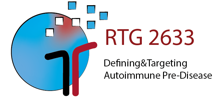MD A9: Impact of glycosylation on IgG4-induced signaling in neutrophils
A key step in the pathogenesis of epidermolysis bullosa acquisita (EBA) is the development of anti-hCOL7 antibodies directed against collagen type VII, which serves as an anchor fibril between the epidermis and the dermis. Activation of neutrophils by COL7/anti-hCOL7 immunocomplexes lead to complement activation and reactive oxygen species (ROS) release, resulting in split formation at the dermal-epidermal junction. This becomes visible as blistering of the skin.1,2 Pathogenicity of autoantibodies depends on the antibody subclass. 2 Within the same subclass, cellular functions and inflammatory activity of the neutrophils are determined by the sugar moiety attached to the antibodies.3 In my project, I will investigate the kinome signature in neutrophils activated by differentially glycosylated IgG4 immunocomplexes. Furthermore, I will determine specific kinase activity by measuring the phosphorylation of kinases by Western blot. The most important cellular function will be the release of ROS, which will be measured by a luminescence-based assay.

- Projects
- A: Defining Autoimmune Pre-Disease
- B: Targeting of Autoimmune Pre-Disease
- Associated projects
- MD projects
- Associated MD projects
- Concluded Projects
- PhDs
- Ass. projects
- MDs
- MD A1 - Investigation of the influence of specific CDK inhibitors on neutrophil activation
- MD A2 - Conception of an anatomical expression of landscape of target antigens in autoimmune blistering dermatoses as markers for lesion formation
- MD A3 - Structural characterization of skin-directed autoantibodies and their interaction with the antigen to gain insights into autoimmune pre-disease
- MD A4 - Do interactions between AT1R autoantibodies derived from patients with systemic sclerosis and endothelial cells lead to endothelial dysfunction?
- MD A5 - Optimization and exploitation of a 3D model of human skin for translational use
- MD A6- To study vasculopathy in systemic sclerosis
- MD A7- Identification of autoantibodies contributing to the break of immunotolerance in immunization induced MMP mouse model
- MD A8- The role of AT1R antibodies and extracellular vesicles in mediating endothelial dysfunction in systemic sclerosis with pulmonary arterial hypertension
- MD A9- Impact of glycosylation on IgG4-induced signaling in neutrophils
- MD A10- Testing a new single chain variable fragment for pemphigus foliaceus in the human skin organ culture model
- MD A11- Impact of glycosylation on IgG3-induced signaling in neutrophiles
- MD A12- Screening for inhibitors to prevent keratinocytes dissoziation
- MD A13- Investigation of the local and systemic complement activation in bullous pemphigoid
- MD A14 - Impact of different subclasses on immune complex-induced signaling in neutrophils.
- MD A15 - Novel target antigens as inducers of autoimmunity of autoimmune bullous dermatoses
- MD A16 - Identification of the major epitope of the BP180 ectodomain recognized by serum IgA autoantibodies of patients with pemphigoid diseases –IgA autoantibodies as prognostic marker?
- MD A19 - Role of Staphylococcus aureus on immunogenic cell death induction in autoimmune vasculitis
- MD B1 - Testing the effect of kinase inhibitors in the human skin organ culture model
- MD B2 - Cigarette smoking-induced autoantibodies
- MD B3 - Contribution of taurine, hypoxanthine, vitamin B5 and B6 in the pathomechanism of pemphigus vulgaris
- MD B5 - Molecular characterization of the pre-autoimmune effects of Western diet in healthy mice
- Ass MDs







